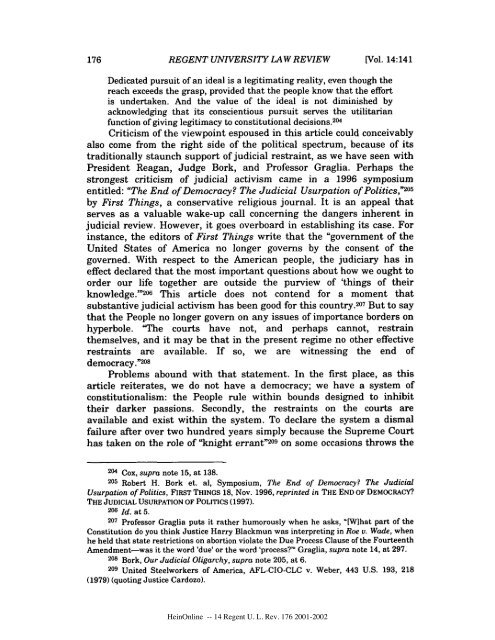Judicial ReEngineering
Judicial ReEngineering
Judicial ReEngineering
Create successful ePaper yourself
Turn your PDF publications into a flip-book with our unique Google optimized e-Paper software.
REGENT UNIVERSITY LAW REVIEW<br />
[Vol. 14:141<br />
Dedicated pursuit of an ideal is a legitimating reality, even though the<br />
reach exceeds the grasp, provided that the people know that the effort<br />
is undertaken. And the value of the ideal is not diminished by<br />
acknowledging that its conscientious pursuit serves the utilitarian<br />
function of giving legitimacy to constitutional decisions. 20 4<br />
Criticism of the viewpoint espoused in this article could conceivably<br />
also come from the right side of the political spectrum, because of its<br />
traditionally staunch support of judicial restraint, as we have seen with<br />
President Reagan, Judge Bork, and Professor Graglia. Perhaps the<br />
strongest criticism of judicial activism came in a 1996 symposium<br />
entitled: "The End of Democracy? The <strong>Judicial</strong> Usurpation of Politics," 20 5<br />
by First Things, a conservative religious journal. It is an appeal that<br />
serves as a valuable wake-up call concerning the dangers inherent in<br />
judicial review. However, it goes overboard in establishing its case. For<br />
instance, the editors of First Things write that the "government of the<br />
United States of America no longer governs by the consent of the<br />
governed. With respect to the American people, the judiciary has in<br />
effect declared that the most important questions about how we ought to<br />
order our life together are outside the purview of 'things of their<br />
knowledge. ' "' 2 6 This article does not contend for a moment that<br />
substantive judicial activism has been good for this country. 2 7 But to say<br />
that the People no longer govern on any issues of importance borders on<br />
hyperbole. "The courts have not, and perhaps cannot, restrain<br />
themselves, and it may be that in the present regime no other effective<br />
restraints are available. If so, we are witnessing the end of<br />
democracy." 208<br />
Problems abound with that statement. In the first place, as this<br />
article reiterates, we do not have a democracy; we have a system of<br />
constitutionalism: the People rule within bounds designed to inhibit<br />
their darker passions. Secondly, the restraints on the courts are<br />
available and exist within the system. To declare the system a dismal<br />
failure after over two hundred years simply because the Supreme Court<br />
has taken on the role of "knight errant" 20 9 on some occasions throws the<br />
204 Cox, supra note 15, at 138.<br />
205 Robert H. Bork et. al, Symposium, The End of Democracy? The <strong>Judicial</strong><br />
Usurpation of Politics, FIRST THINGS 18, Nov. 1996, reprinted in THE END OF DEMOCRACY?<br />
THE JUDICIAL USURPATION OF POLITICS (1997).<br />
206 Id. at 5.<br />
207 Professor Graglia puts it rather humorously when he asks, "[Wihat part of the<br />
Constitution do you think Justice Harry Blackmun was interpreting in Roe v. Wade, when<br />
he held that state restrictions on abortion violate the Due Process Clause of the Fourteenth<br />
Amendment-was it the word 'due' or the word 'process?'" Graglia, supra note 14, at 297.<br />
208 Bork, Our <strong>Judicial</strong> Oligarchy, supra note 205, at 6.<br />
209 United Steelworkers of America, AFL-CIO-CLC v. Weber, 443 U.S. 193, 218<br />
(1979) (quoting Justice Cardozo).<br />
HeinOnline -- 14 Regent U. L. Rev. 176 2001-2002

















